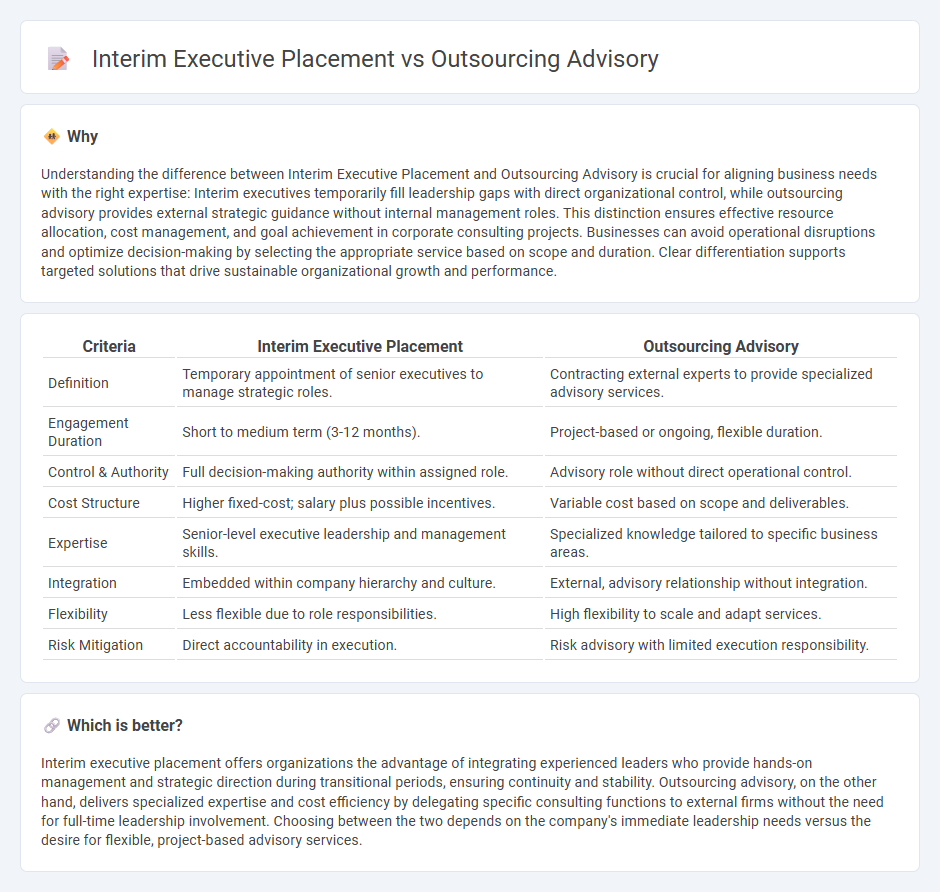
Interim executive placement offers organizations agile leadership by filling critical roles with experienced professionals on a temporary basis, ensuring continuity during transitions or crises. Outsourcing advisory focuses on delegating specific consulting functions to specialized external firms, enabling cost efficiency and access to niche expertise without long-term commitments. Explore detailed comparisons to determine which approach best aligns with your business objectives.
Why it is important
Understanding the difference between Interim Executive Placement and Outsourcing Advisory is crucial for aligning business needs with the right expertise: Interim executives temporarily fill leadership gaps with direct organizational control, while outsourcing advisory provides external strategic guidance without internal management roles. This distinction ensures effective resource allocation, cost management, and goal achievement in corporate consulting projects. Businesses can avoid operational disruptions and optimize decision-making by selecting the appropriate service based on scope and duration. Clear differentiation supports targeted solutions that drive sustainable organizational growth and performance.
Comparison Table
| Criteria | Interim Executive Placement | Outsourcing Advisory |
|---|---|---|
| Definition | Temporary appointment of senior executives to manage strategic roles. | Contracting external experts to provide specialized advisory services. |
| Engagement Duration | Short to medium term (3-12 months). | Project-based or ongoing, flexible duration. |
| Control & Authority | Full decision-making authority within assigned role. | Advisory role without direct operational control. |
| Cost Structure | Higher fixed-cost; salary plus possible incentives. | Variable cost based on scope and deliverables. |
| Expertise | Senior-level executive leadership and management skills. | Specialized knowledge tailored to specific business areas. |
| Integration | Embedded within company hierarchy and culture. | External, advisory relationship without integration. |
| Flexibility | Less flexible due to role responsibilities. | High flexibility to scale and adapt services. |
| Risk Mitigation | Direct accountability in execution. | Risk advisory with limited execution responsibility. |
Which is better?
Interim executive placement offers organizations the advantage of integrating experienced leaders who provide hands-on management and strategic direction during transitional periods, ensuring continuity and stability. Outsourcing advisory, on the other hand, delivers specialized expertise and cost efficiency by delegating specific consulting functions to external firms without the need for full-time leadership involvement. Choosing between the two depends on the company's immediate leadership needs versus the desire for flexible, project-based advisory services.
Connection
Interim executive placement and outsourcing advisory intersect through their focus on flexible leadership solutions that drive organizational efficiency. Interim executives often guide companies in identifying and implementing outsourcing strategies to optimize operations and reduce costs. This synergy enhances business agility by combining expert temporary leadership with strategic outsourcing decisions.
Key Terms
Outsourcing advisory:
Outsourcing advisory provides expert guidance to companies seeking to optimize their operations by delegating non-core functions to specialized external providers, enhancing efficiency and cost-effectiveness. It involves strategic assessment, vendor selection, contract negotiation, and performance management to ensure alignment with business goals. Explore our comprehensive outsourcing advisory services to streamline your processes and maximize value.
Vendor Management
Outsourcing advisory services specialize in vendor management by analyzing, selecting, and negotiating with third-party suppliers to optimize cost and performance. Interim executive placement provides temporary leadership with expertise in managing vendor relationships and driving strategic initiatives during transitional periods. Explore detailed strategies and benefits of each approach to enhance your vendor management process.
Service Level Agreements (SLA)
Service Level Agreements (SLA) play a critical role in both outsourcing advisory and interim executive placement by clearly defining performance standards, deliverables, and accountability measures to ensure service quality and alignment with business objectives. In outsourcing advisory, SLAs focus on operational benchmarks, such as response times and issue resolution, to manage external vendor performance effectively. Explore our comprehensive guide to understand how tailored SLA strategies optimize outcomes in different service models.
Source and External Links
Outsourcing Advisory Firms Guide - Outlines how outsourcing advisory firms guide businesses in identifying outsourcing opportunities, selecting providers, managing relationships, and optimizing total value and cost savings.
Outsourcing Advisory - West Monroe - Offers end-to-end outsourcing strategy, vendor selection, contract negotiation, and ongoing performance management to help clients maximize efficiency, minimize risk, and drive growth.
Outsourcing Advisory - AdviseCX - Provides comprehensive outsourcing advisory, including cost-benefit analysis, change management, sustainability integration, vendor governance, and robust exit strategies to ensure business continuity and long-term value.
 dowidth.com
dowidth.com